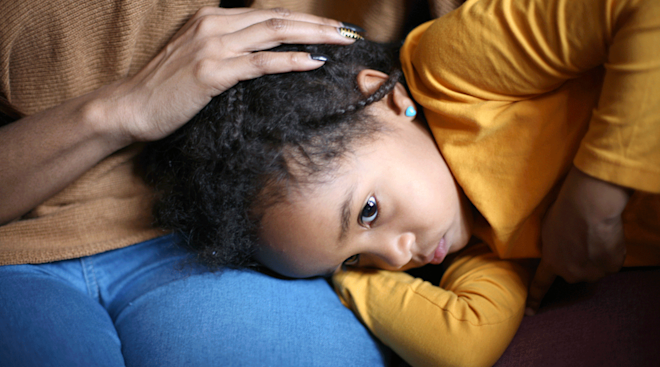What to Know About Jaundice in Babies
By the time you reach the end of your pregnancy, we’re guessing you’re more than ready to start your journey into parenthood. You’ve read plenty of baby books, attended birthing classes and know way too much about newborn poop. But there’s one thing you may not be ready for, and that’s for baby to take on a yellowish tint shortly after birth. While it can seem bizarre, there’s no need to panic: Baby likely has jaundice, a common newborn condition, affecting up to 60 percent of full term infants. “Jaundice in newborns creates a lot of concern because it happens when they’re just a couple days old,” says Alanna Levine, MD, a pediatrician at Orangetown Pediatric Associates in Orangeburg, New York. “But the bottom line is that all babies have some degree of jaundice, and it’s easily fixable.”
Jaundice is a medical condition that causes baby’s skin and the whites of her eyes to appear yellow. Also known as hyperbilirubinemia, it’s caused by an excess of bilirubin, a yellowish substance that’s released into the bloodstream when the body breaks down red blood cells. Normally, the liver processes the bilirubin without a problem, but babies’ livers are still immature, explains Joshua Friedman, MD, a member of the American Liver Foundation’s Medical Advisory Committee and assistant professor of pediatrics at the University of Pennsylvania Children’s Hospital of Philadelphia. Up until birth, bilirubin was excreted from baby’s body through the placenta. After birth, baby’s body has to “gear up” to remove bilirubin itself, which happens mainly through urine and bowel movements. In the meantime, Friedman says, “Bilirubin can accumulate in the blood and be visible in the skin.”
Baby’s early inability to get rid of excess bilirubin is what causes jaundice, but there are a few factors that can affect how likely baby is to develop the condition:
• Rh incompatibility. According to Lori Christ, MD, attending neonatologist in the division of neonatology at Children’s Hospital of Philadelphia, infant jaundice can occur when there’s an Rh incompatibility between a pregnant mom and her baby. That means if mom’s blood type is Rh-negative and baby’s is Rh-positive, mom’s blood will treat baby’s as a foreign body and develop antibodies against it. As these antibodies cross the placenta, they can damage baby’s red blood cells and cause a buildup of bilirubin, which leads to jaundice in newborns. This complication isn’t very common, however, since pregnant women are typically given a RhoGAM shot (a solution collected from plasma donors) to prevent these antibodies if an Rh incompatibility is determined.
• ABO incompatibility. Similar to the above, ABO incompatibility occurs in situations where mom’s blood type—typically type O, according to Christ—is different from baby’s and antibodies are produced. But unlike RH incompatibility, it can only be diagnosed after birth, so there’s no preventative measure. These cases of jaundice are usually treated with phototherapy (more on that below).
• Prematurity. Even if baby’s born full term, her liver is still a bit immature for the first few days. This often leads to mild cases of jaundice, since the liver may not be able to rid the body of bilirubin. But jaundice in newborns who are premature is even more likely to appear, since their livers are less developed than their full-term counterparts.
Can breastfeeding cause jaundice?
It’s interesting to note that there are two other types of jaundice associated with breastfeeding:
• Breastfeeding jaundice. About 1 in 10 infants develop this version of jaundice, which tends to appear in the first week of life. According to the CDC, it’s thought to occur when baby isn’t getting enough milk, leading to dehydration or low caloric intake. This, in turn, affects baby’s ability to secrete bilirubin, “because feeding and the resulting bowel movements are the main way bilirubin is removed from the body,” Friedman says. Upping the number of nursing sessions, pumping between feedings and using galactogogues—aka substances that promote the secretion of milk—can help increase your supply and treat jaundice. It’s not recommended to supplement with formula, though, since that can lead to a further decrease in milk supply. Speak with a lactation consultant, who can help address any breastfeeding challenges and ensure baby is getting enough milk.
• Breast milk jaundice. This type of jaundice in babies is far less common, occuring in only 1 in 200 infants. It usually peaks two to three weeks after birth and, according to the CDC, is caused by substances in mom’s milk that decrease the ability of baby’s liver to eliminate bilirubin. Breast milk jaundice can last for anywhere from three to 12 weeks but is harmless and, as long as baby is feeding well and bilirubin levels are being monitored, isn’t usually a reason to stop nursing.
If your newborn develops jaundice, Friedman recommends consulting with your pediatrician, since other, more serious conditions can also cause jaundice to appear in the first few weeks of life.
Of all the jaundice symptoms, the most common is a noticeable yellow tinge to baby’s skin and the whites of her eyes. Other signs of jaundice in newborns jaundice include:
- Weight loss
- Excessive fussiness
- Extreme fatigue or lethargy
- Poor feeding
One way to informally test for jaundice in babies: Press your finger against baby’s nose or forehead. When you take your finger away, does the skin underneath look yellowish, or is it just a lighter shade of baby’s normal color? If the skin looks yellow, baby probably has jaundice, and you should consult baby’s doctor.
If baby’s looking a little yellow before you head home from the hospital, her doctor will likely order a simple blood test to confirm the presence of jaundice. So how do doctors decide whether and how to treat baby’s jaundice? According to Michelle Leff, MD, associate professor of pediatrics at the University of California San Diego, it’s a combination of factors: “The threshold is different based on baby’s weight, gestational age at birth and age in hours of life.”
Treatment for moderate jaundice in newborns
For mild cases, jaundice treatment may not be required at all, since it typically resolves on its own. In moderate cases, the most common jaundice treatment is phototherapy. Light of a specific blue wavelength is used to cause a chemical change in the bilirubin, which allows it to be excreted from the body, says Friedman. Light therapy is an extremely effective baby jaundice treatment. These days, rather than exposing baby to sunlight for jaundice, most health care providers now use a biliblanket, which is an at-home treatment consisting of a fiber optic pad that delivers light to baby. This allows baby to continue jaundice treatment without staying in the hospital. Even better? A team of researchers in Switzerland is working on developing what they call “photonic textiles”—wearable infant jaundice pajamas with bili-lights woven into the fabric.
Treatment for severe jaundice in newborns
In serious cases of jaundice—often those brought on by Rh or ABO incompatibilities—IV therapy or even a blood transfusion may be necessary. According to Christ, IV immunoglobulin (an antibody delivered intravenously) is a medication that helps prevent the ongoing reaction between mom’s blood type and baby’s blood type.
Unfortunately, there’s no tried-and-true way to prevent jaundice in newborns entirely, but Christ says good prenatal care is a start, especially if baby is at risk for a complication between blood types. After baby arrives, it’s important to keep his belly full. “Jaundice can be staved off by good feeding,” Leff says. “That’s really the only thing that you can do to try to prevent it.”
Updated December 2017
Please note: The Bump and the materials and information it contains are not intended to, and do not constitute, medical or other health advice or diagnosis and should not be used as such. You should always consult with a qualified physician or health professional about your specific circumstances.
Navigate forward to interact with the calendar and select a date. Press the question mark key to get the keyboard shortcuts for changing dates.




















































